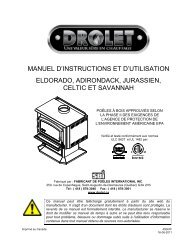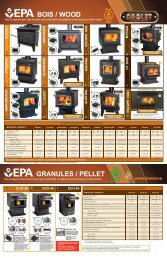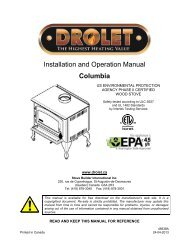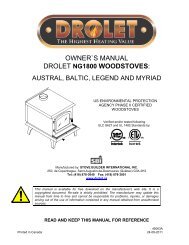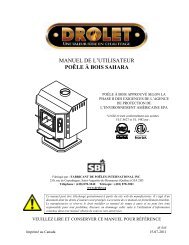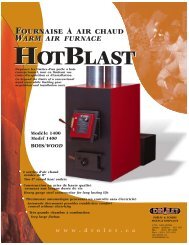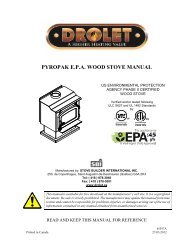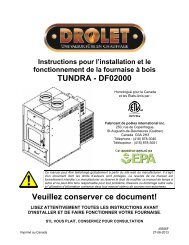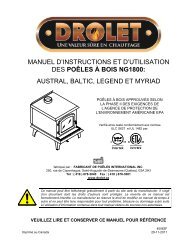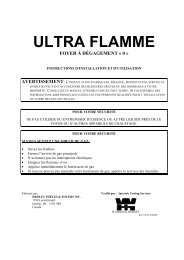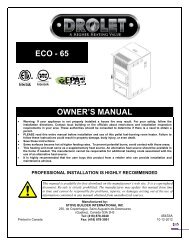Create successful ePaper yourself
Turn your PDF publications into a flip-book with our unique Google optimized e-Paper software.
BLOWERS AND PRESSURE SWITCH PROBEDANGER: RISK OF ELECTRIC SHOCK.SERVICING UNIT.DISCONNECT POWER BEFOREBlower Cleaning – Over a period of time, ashes or dust may collect on <strong>the</strong>blades of both <strong>the</strong> combustion/exhaust blower and convection blower.Periodically, <strong>the</strong> blowers should be cleaned as <strong>the</strong> ash and dust canimpede performance. The combustion/exhaust blower can be accessed byopening <strong>the</strong> left, right, and back panels.(Figure 25) To clean <strong>the</strong> blades in<strong>the</strong> combustion housing, insert <strong>the</strong> vacuum tip through <strong>the</strong> air inlet damperopening located on <strong>the</strong> side of <strong>the</strong> combustion housing. Clean thoroughly.To clean <strong>the</strong> blades in <strong>the</strong> exhaust housing, use a screw driver to remove<strong>the</strong> cleaning access panel located on <strong>the</strong> side of <strong>the</strong> metal box covering <strong>the</strong>housing. Insert <strong>the</strong> vacuum tip through <strong>the</strong> cleaning outlet and clean <strong>the</strong>blades thoroughly.Pressure switch probe cleaning - Ashes may accumulate on inside tip of<strong>the</strong> pressure switch probe connector. Use a mesh pad or wire brush toclean <strong>the</strong> connector and blow inside <strong>the</strong> tube to make sure it’s free ofobstruction.NOTE: When cleaning, be careful not to bend fan blades. Some stove owners lightly spray ananti-creosote chemical on <strong>the</strong> fire to help reduce creosote formation within <strong>the</strong> stove.PROBE CONNECTORFigure 25Exhaust blower cleaningCHIMNEY CLEANINGa. Creosote Formation – When any wood is burned slowly, it produces tar and o<strong>the</strong>r organic vapours, which combine with expelled moisture to formcreosote. The creosote vapours condense in <strong>the</strong> relatively cool chimney flue or a newly started fire or from a slow-burning fire. As a result, creosoteresidue accumulates on <strong>the</strong> flue lining. When ignited, this creosote makes an extremely hot fire, which may damage <strong>the</strong> chimney or even destroy<strong>the</strong> house. Despite <strong>the</strong>ir high efficiency, pellet stoves can accumulate creosote under certain conditions.b. Fly Ash – This accumulates in <strong>the</strong> horizontal portion of an exhaust run. Though non-combustible, it may impede <strong>the</strong> normal exhaust flow. It should<strong>the</strong>refore be periodically removed.c. Inspection and Removal – The chimney connector and chimney should be inspected annually or per ton to determine if a creosote or fly ash builduphas occurred. If creosote has accumulated, it should be removed to reduce <strong>the</strong> risk of a chimney fire. Inspect <strong>the</strong> system at <strong>the</strong> stove connectionand at <strong>the</strong> chimney top. Cooler surfaces tend to build creosote deposits quicker, so it is important to check <strong>the</strong> chimney from <strong>the</strong> top as well as from<strong>the</strong> bottom.The creosote should be removed with a brush specifically designed for <strong>the</strong> type of chimney in use. A qualified chimney sweep can perform this service. Itis also recommended that before each heating season <strong>the</strong> entire system be professionally inspected, cleaned and, if necessary, repaired.To clean <strong>the</strong> chimney, disconnect <strong>the</strong> vent from <strong>the</strong> stove.21



